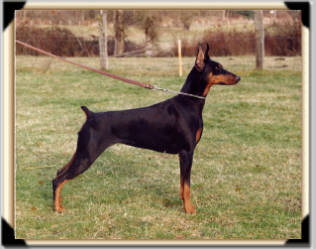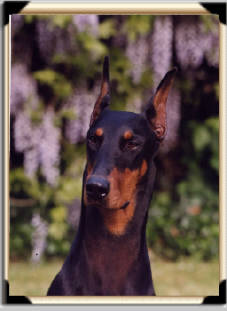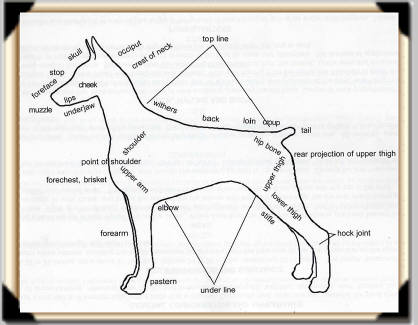



Head : The head of the Doberman should be long and clean (dry) with equal length of muzzle and forehead as measured from the center of the stop. The face is filled under the dark, almond-shaped eye with its alert expression. The forehead is flat and the cropped ears are held straight above the head, not out to the side, when at attention. The planes of the forehead and muzzle should be parallel with a slight stop dividing them. When viewed from the front, the cheeks should be flat into the full muzzle, giving the apperance of a long, blunt wedge.
A Discussion of the the Doberman Standard
Overall Appearance : The Doberman in intended to be a medium-sized dog with large, round bone. Ideally, the male should stand at about 27 1/2 inches at the withers (top of the shoulders) and the female at 25 1/2 inches. We often hear an owner talking about how tall and heavy their Doberman is, perhaps, unaware that these characteristics are far from ideal. The Doberman, as a protection animal, should be agile, athletic and fleet in movement. Excessive size would tend to detract from his duties as a working dog. Excellent muscle tone and the appearance of being "poured" into the skin are characteristics that lend to the beauty and style of this dog. The Dobermans is described as square in body, equally balanced front and rear, so as to give the appearance, both standing and moving, of a smooth, one-piece dog. When at attention, he projects an air of confidence by his alert, watchful, intelligent demeanor.
Body : The body of the mature Doberman should be full when viewed from above with a slight narrowing of the strong loin. The ribs should be well sprung with the brisket extending deep to the elbow and then tapering gradually to a tucked-up belly. The elbows fit closely to the body. The body is square when measured from the top of the shoulder to the ground (vertically) and from the point of the hip bone to the forechest (horizontally).
The Doberman standard was created as a guide by which breeders and judges can evaluated how each dogs conforms to the hypothetical ideal of the breed. While we all know that there is no perfect Doberman, by acknowledging the standard in our breeding practices, we are more likely to maintain the true essence of what a Doberman is suppose to be, both in conformation and in temperament.